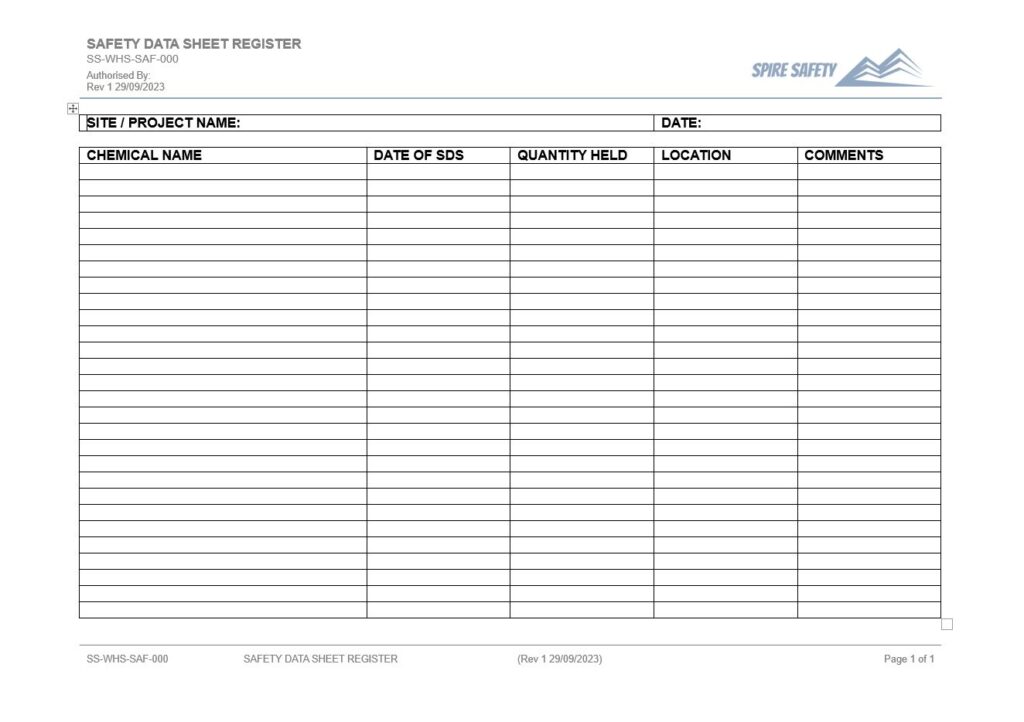Free Safety Data Sheet Register Template
Download our free Safety Data Sheet Register Template:
*For internal use only. Not for resale or redistribution. By downloading, you agree to our Free Resources Licensing Agreement.
 Purpose of Document
Purpose of Document
Safety Data Sheet Register templates are used to list hazardous substances that are being used in a workplace. The primary goal is to protect workers from injury or illness by providing a list of hazardous substances and SDS. This form is broadly aligned with AS45001:2018.
How to Use
Fill out the register by adding details of all the hazardous chemicals at your workplace.
This document is a template only and it must be customised for your business. Other aspects that may need to be considered include, but are not limited to, ensuring that:
- Relevant legal requirements have been met,
- Workplace specific risks are identified and managed, and
- Workers are consulted with during the customisation / review process.
When to Use
Safety Data Sheet Register templates should be updated continually to remain up-to-date.
Who Should Use
This form can be completed by your workers, Safety Advisor, Project Manager or other competent person in your organisation.
Legal Considerations
Maintaining a Safety Data Sheet Register is a legal requirement outlined within:
- s(346) WHS Regulations – Hazardous chemicals register
Other legal duties that may be relevant include:
- s(19)(3)d WHS Act – Duty to Ensure Safe Use, Handling and Storage of Substances
FAQ
What is a SDS (Safety Data Sheet)?
A Safety Data Sheet (SDS) is a standardized document that provides crucial information about hazardous chemicals. It includes details on chemical properties, physical, health, and environmental hazards, as well as protective measures and safety precautions.
What is a hazardous substance / hazardous chemical?
Hazardous chemicals refer to substances, mixtures, or articles that pose risks to health and safety. These risks can manifest immediately, causing poisoning or burns, or lead to long-term health conditions
How do I know if a substance or chemical is hazardous?
Section 2 of the Safety Data Sheet (SDS) “Hazard(s) Identification” will usually contain a statement saying whether the substance is classed as hazardous or not. This section of the SDS also outlines the hazards associated with the substance.
What are the four routes of exposure?
The four routes of exposure are:
- Inhalation (breathing)
- Ingestion (swallowing)
- Absorption (skin / eyes)
- Injection
Article Sources and Further Reading
- Classifying chemicals in Australia (Safe Work Australia) <https://www.safeworkaustralia.gov.au/safety-topic/hazards/chemicals/classifying-chemicals/classifying-chemicals-australia>
- Safety data sheets – Chemicals (Safe Work Australia) <https://www.safeworkaustralia.gov.au/safety-topic/hazards/chemicals/safety-data-sheets>
- Chemical Safety Training (Spire Safety) <https://spiresafety.com.au/whs-training/non-accredited-whs-training/chemical-safety-awareness-course/>

 Purpose of Document
Purpose of Document